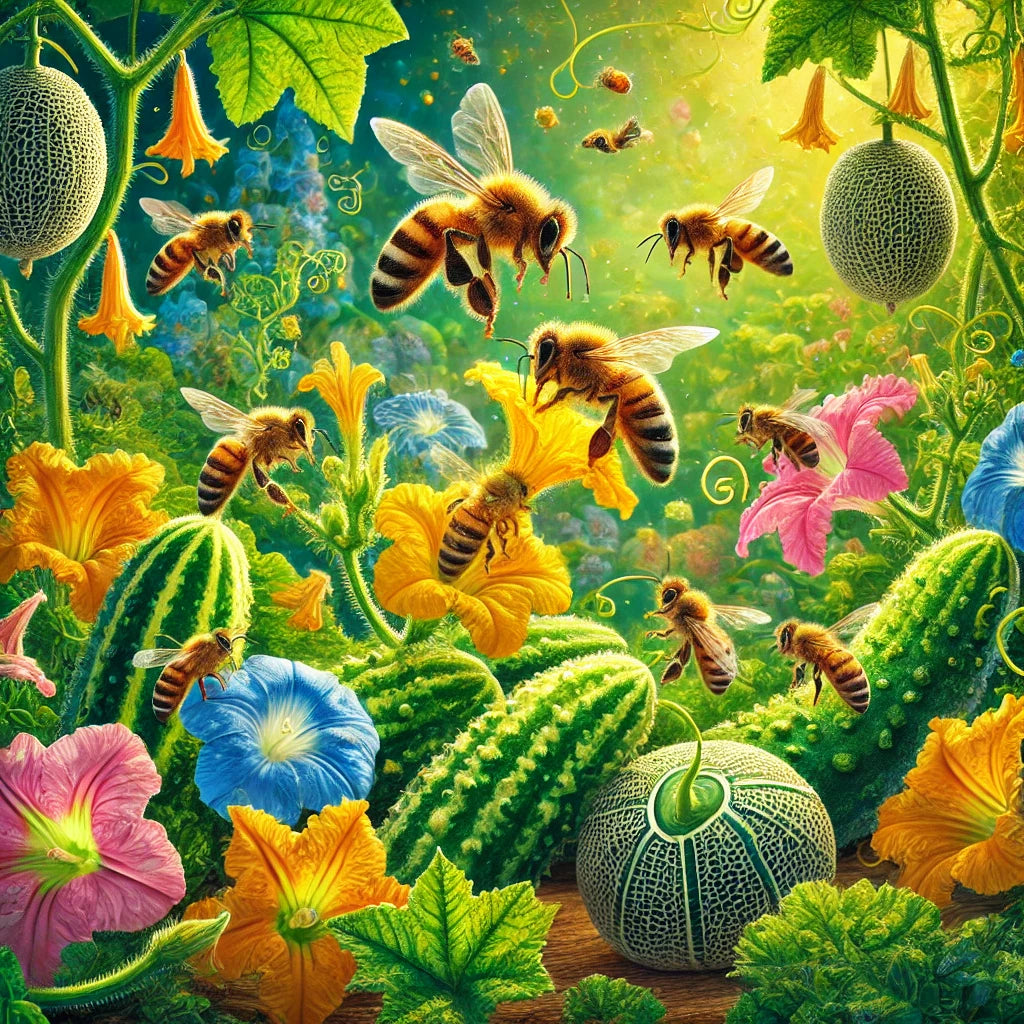Cucumbers and cantaloupes, like many members of the cucurbit family, require pollination to grow properly. When pollination is incomplete, the fruits develop abnormally, often leading to misshapen, small, or hollow produce.
Understanding how male vs female cantaloupe flowers play a role in this process can help growers and gardeners maximize their yield and ensure healthy, fully-formed fruits.
Male and Female Flowers: The Basics of Cucumber Pollination
Cucumbers and cantaloupes are monoecious, meaning they have both male and female flowers on the same plant. Male flowers produce pollen, while female flowers, distinguished by a small ovary at the base, receive it. Successful pollination requires bees or other pollinators to transfer pollen from the male flowers to the female flowers.
Incomplete pollination happens when the pollen transfer is insufficient, leading to deformed cucumbers or cantaloupes with parts that are underdeveloped. This problem is often caused by a lack of bee activity or poor weather conditions that prevent bees from foraging effectively. Adequate pollination can require multiple bee visits to each flower for full fertilization.
How Pollinators Impact Fruit Development
The role of pollinators, particularly honey bees, is critical for the pollination of cucumbers and cantaloupes. Bees are attracted to the flowers, transferring pollen from the male flowers to the female flowers. However, cucurbits often have more male flowers than female, which can make pollination less efficient if there aren’t enough bees or if the male flowers outnumber the female flowers significantly.
In some cases, honey bee swarms can be beneficial for increasing pollination rates, as swarming bees are highly active in searching for nectar, making multiple visits to flowers. It's important to maintain a strong population of pollinators to avoid problems like hollow or misshapen fruits. Learn more about the role of bees in agriculture in this guide on why honeybees are vital to agriculture.
Problems Caused by Incomplete Pollination
Incomplete pollination can lead to several issues in cucurbits, including hollow hearts, misshapen fruits, and smaller yields. The affected parts of the fruit are typically where fertilization did not occur, leaving underdeveloped seeds and sections that lack the normal juiciness and texture.
A common visual sign of incomplete pollination in cucumbers and melons is uneven growth—certain parts of the fruit will be full and plump, while others will be small or shriveled. These deformities are caused by insufficient fertilization of the seeds. The more seeds that are successfully pollinated, the larger and fuller the fruit will become. This is why maintaining a healthy population of bees and ensuring proper pollination is so crucial for farmers and gardeners alike.
The Importance of Supporting Pollinators
Given the importance of pollinators like bees in ensuring complete pollination, it’s essential to support their populations. One way to do this is by encouraging bees to visit your garden or farm. Beekeepers can also use bee trap attractants to direct bees toward specific areas for improved pollination. Maintaining a healthy, active bee population can increase the number of visits to female flowers, reducing the likelihood of incomplete pollination and improving crop yields(
Starting a bee farm is another great way to support pollination efforts on a larger scale. Beekeepers looking to contribute to their crops' pollination can find helpful resources on how to start a bee farm to build a sustainable, productive bee colony.
Enhance Your Pollination Success with Swarm Commander
Complete pollination is essential for producing well-formed cucumbers and cantaloupes. Understanding the differences between male and female flowers and ensuring the right pollinators, like honey bees, can improve your yields and prevent issues like hollow or misshapen fruits.
Maintaining a healthy bee population is critical to achieving full fertilization, and tools like bee trap attractants can help direct bees to your crops, ensuring frequent and successful pollination. Proper pollination is not only beneficial for your garden but also contributes to the overall health of the ecosystem and the productivity of agriculture.
Ready to boost your pollination rates and support a thriving garden or farm? Equip yourself with the best beekeeping tools from Swarm Commander. From bee trap attractants to solutions for bee hive relocation, our products are designed to help you manage bee populations effectively and enhance pollination success. Visit our store today and take the next step toward a more productive and healthy harvest!
Frequently Asked Questions About Incomplete Cucumber Pollination
Q1. Why are my cucumbers misshapen?
Misshapen cucumbers are often the result of incomplete pollination. When bees don’t transfer enough pollen from male to female flowers, the seeds aren’t fully fertilized, causing irregular fruit development.
Q2. How can I improve cucumber pollination?
You can improve pollination by attracting more pollinators, such as honey bees, to your garden. Using products like bee trap attractants can help guide pollinators to your plants, ensuring more frequent and thorough visits.
Q3. What’s the difference between male and female flowers in cucumbers and cantaloupes?
Male flowers produce pollen, while female flowers receive the pollen and have a small ovary beneath the petals, which will develop into the fruit once pollination occurs.
Q4. Can I hand-pollinate cucumbers and cantaloupes?
Yes, hand-pollination is possible by transferring pollen from male flowers to female flowers using a small brush. This can be especially helpful when bee activity is low.
Q5. How do I identify incomplete pollination in my cucumbers and cantaloupes?
Incomplete pollination often leads to hollow or misshapen fruits. These deformed areas usually appear where seeds were not fully fertilized.



